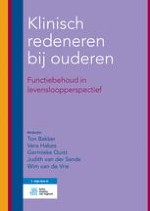2017 | OriginalPaper | Hoofdstuk
7g Incontinentie en obstipatie
Auteur : Paul van Houten
Gepubliceerd in: Klinisch redeneren bij ouderen
Uitgeverij: Bohn Stafleu van Loghum
Samenvatting
-
Urine-incontinentie komt bij ouderen veel voor (29-90%). De lagere prevalenties worden gerapporteerd bij zelfstandig wonenden; de hogere prevalenties worden gevonden in woon-zorgwelzijnsinstellingen. Ook fecale incontinentie komt veel voor bij ouderen (2,2-50%; lagere prevalenties bij zelfstandig wonenden). De prevalentie van obstipatie varieert van 14,9 tot 40% (paragraaf 7 g.2).
-
Er zijn diverse typen incontinentie, die gekarakteriseerd worden door de aandoeningen die in de verschillende systemen kunnen ontstaan (paragraaf 7 g.3).
